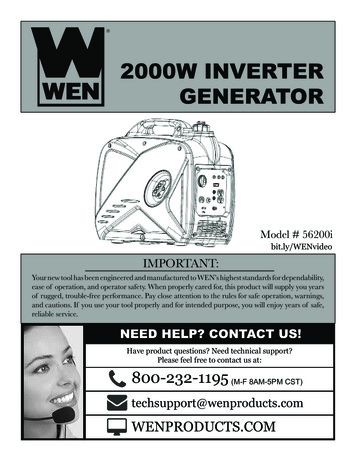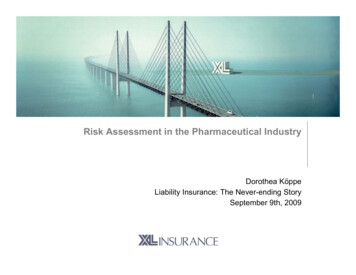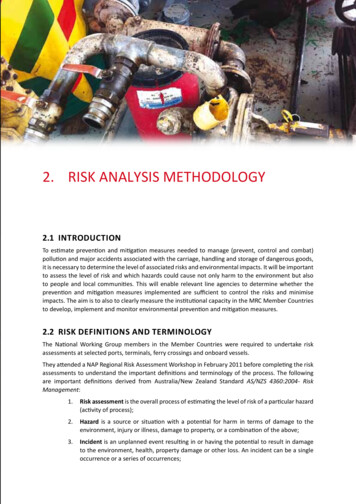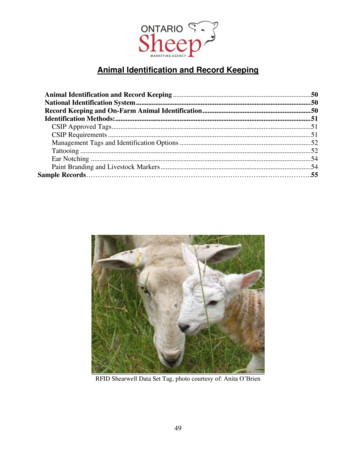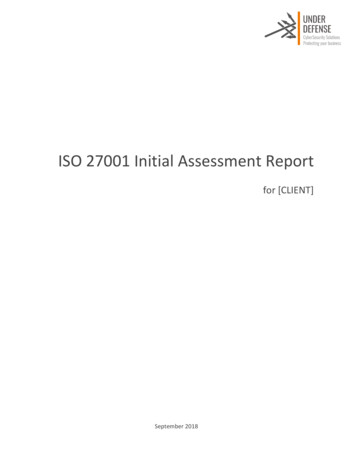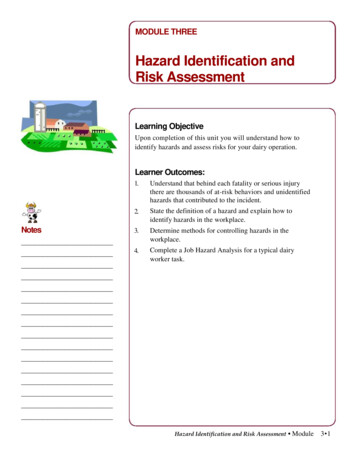
Transcription
MODULE THREEHazard Identification andRisk AssessmentLearning ObjectiveUpon completion of this unit you will understand how toidentify hazards and assess risks for your dairy operation.Learner Outcomes:Notes1.Understand that behind each fatality or serious injurythere are thousands of at-risk behaviors and unidentifiedhazards that contributed to the incident.2.State the definition of a hazard and explain how toidentify hazards in the workplace.3.Determine methods for controlling hazards in theworkplace.4.Complete a Job Hazard Analysis for a typical dairyworker task.Hazard Identification and Risk Assessment Module3 1
IntroductionSafety in any operation works best if the person or people incharge take a leading role in managing safety and health.Many business enterprises have proven that good safetymanagement leads to increased productivity, and the same worksfor farms.By having a good safety management program, you can avoidnot only farm injuries, but also other incidents that are costly, timeconsuming, stressful and inconvenient. This makes good economicsense.Safety PyramidIn 2003, ConocoPhillips Marine conducted a studydemonstrating a large difference in the ratio of serious accidentsand near misses. This study was built on the original work of H.W.Heinrich back in 1931. The Conoco study found that for everysingle fatality there are at least 300,000 at-risk behaviors, definedas activities that are not consistent with safety programs, trainingand components on machinery. These behaviors may includebypassing safety components on machinery or eliminating a safetystep in the production process that slows down the operator. Witheffective machine safeguarding and training, at-risk behaviors andnear misses can be diminished. This also reduces the chance of thefatality occurring, since there is a lower frequency of at-riskbehaviors.Notes2 Module 3 Center for Dairy Farm Safety - University of Wisconsin - River Falls & Wisconsin Extension
Definition of a hazardNotesA hazard is simply a condition or set of circumstances thatpresents a potential for harm. Hazards are divided into twobroad categories: Health hazards (cause occupational illnesses)Safety hazards (cause physical harm - injuries)Hazard IdentificationHazard identification is the process of identifying all hazards inthe workplace. There is no set method for grouping agriculturalinjury and illness hazards. Most production agriculture hazardsoverlap into different hazard categories. One way to group themwould be by major hazards listed in the OSHADairy Local Emphasis Program: Manure storage facilities and collections structuresDairy bull and cow behavior/worker positioningElectrical systemsSkid-steer loader operationTractor operationGuarding of power take-offs (PTOs)Guarding of other power transmission and functionalcomponentsHazardous energy control while performing servicingand maintenance on equipmentHazard communicationConfined spacesHorizontal bunker silosNoiseHazards are the main cause of occupational health and safetyproblems. Therefore, finding ways of eliminating hazards orcontrolling the risks is the best way to reduce workplace injury andillness.Toolbox Item: Hazard Prevention and ControlHazard Identification and Risk Assessment Module 3 3
How to StartTo assess safety management on your farm, check whether youhave: Regular hazard assessment surveys of operations,equipment, substances and tasksA system of recording injuries, near misses and identifiedhazardsSafe procedures for dairy farm tasksSafety training and supervision for new and youngemployeesProtective clothing and equipment (PPE)Safety training and practice for each new piece ofequipmentSafety discussions between employers, contractors andemployeesSafety information readily available for hazardoussubstancesCopies of the regulationsDevelop a planDevelop a written safety and health program covering thepoints listed above. (This will be covered in more detail in Module8 - Safety and Health Programs). Keep it with other safetyinformation about operations, equipment and substances on thefarm. Discuss the program with others on the farm duringdevelopment to assure their safety concerns are met.Incorporate a system for hazard identification, riskassessment and risk control.NotesMake sure employees and others on the farm are familiarwith the plan, safe work procedures, and current legalsafety and health requirements.Other components include providing farm workers withsafety information, orientation for new employees, safetytraining for new procedures, special safeguards for youngworkers, and keeping a record of injuries, near misses andpotential hazards.4 Module 3 Center for Dairy Farm Safety - University of Wisconsin - River Falls & Wisconsin Extension
Identify the hazardThe best safety outcomes on farms are achieved by a 24-hourapproach to identifying and dealing with hazards.NotesHazards may be identified in: Environments (light, noise, rain, heat, sun, cold)Substances (pesticides, fuels, dusts)Workplace layout (parlor design, cattle passes)Work organization (unnecessary manual handling)Equipment (ladders, squeeze chutes, crowd gates)Farm animals (that bite, kick, butt, crush, toss, infect)Heights (roofs, vertical and horizontal silos, manure pits)Electricity (switches, cables, leads, power tools,connections)Hazards may be identified by: Observation - use your senses of sight, hearing, smell andtouch - combined with knowledge and experience.Material Safety Data Sheets (MSDSs) - obtain themfrom manufacturers and suppliers. Read them carefullyto identify possible harm from hazardous substances andprecautions that need to be taken.Hazard and risk surveys - conduct hazard spottingsurveys of main work areas. Talk to others about theirsafety concerns.Children and visitors - include in your surveys areas andactivities in which children or visitors could be at risk.Record analysis - keep records of identified hazards, nearmisses, injuries and workers' compensation claims to helpidentify possible trends. Safety audits - consider creating a safety committee toinvestigate safety and help prepare a management plan. Information - keep informed of hazards in the industrythrough the latest available information. Consumer information - carefully read and followconsumer guidelines on equipment and substances. Regulations and best practicesDiscussion groups - are useful for identifying hazardsand recommending solutions.Hazard Identification and Risk Assessment Module 3 5
Assess the RiskOnce a hazard has been identified, the likelihood and possibleseverity of injury or harm will need to be assessed beforedetermining how best to minimize the risk. High risk hazards willneed to be addressed more urgently than low risk situations.You may decide that the same hazard could lead to severaldifferent possible outcomes. For each hazard consider how likelyeach possible outcome is and record the highest priority.Make the changesConsider the following control measures, listed in order ofimportance:a) Remove the hazard at the source - e.g. get rid of it or replace itb) Substitute it with something less hazardous.c) Isolate the hazardous process, item orsubstance from people.d) Add engineering controls, such assafety barriers or exhaust ventilation.e) Adopt safe work procedures, trainingand supervision to minimize the risk.f) Where other means are not sufficient orpracticable, provide personal protective equipment.g) Implement and monitor the controls you decide upon.One or more of the controls recommended above should beagreed upon and the changes made as soon as possible before thehazard causes an injury. Sometimes it will require more than oneof the risk control measures above to effectively reduce exposure tohazards.NotesChecking the changesTo make sure risk has been minimized, and a further hazardhas not been created, the new safety measures may need to becarefully tested before work begins again. Consultation betweenthe employer and others at the workplace will help to reach a safedecision.6 Module 3 Center for Dairy Farm Safety - University of Wisconsin - River Falls & Wisconsin Extension
NotesIn some cases, a new set of safe work procedures may benecessary, possibly even another period of training andsupervision, until the improvement can be shown to be workingsafely. Safety improvements should be reviewed periodically tomake sure they continue to be effective.Job Hazard Analysis (JHA)A job hazard analysis is a technique that focuses on job tasksas a way to identify hazards before they occur. It focuses on therelationship between the worker, the task, the tools, and the workenvironment. Ideally, after you identify uncontrolled hazards, youwill take steps to eliminate or reduce them to an acceptable risklevel.A JHA can be conducted on many jobs in your workplace.Priority should go to the following types of jobs: Jobs with the highest injury or illness rates;Jobs with the potential to cause severe or disablinginjuries or illnesses, even if there is no history of previousaccidents;Jobs in which one simple human error could lead to asevere accident or injury;Jobs that are new to your operation or have undergonechanges in processes and procedures; andJobs complex enough to require written instructions.Where do I begin?1. Involve your employees. It is very important to involveyour employees in the job hazard analysis process. They have aunique understanding of the job and this knowledge is invaluablefor finding hazards. Involving employees will help minimizeoversights, ensure a quality analysis, and get workers to "buy in" tothe solutions because they will share ownership in their safety andhealth program.Hazard Identification and Risk Assessment Module 3 7
2. Review your accident history. Review with youremployees your farm's history of accidents and occupationalillnesses that needed treatment, losses that required repair orreplacement, and any "near misses" -- events in which an accidentor loss did not occur, but could have. These events are indicatorsthat the existing hazard controls (if any) may not be adequate anddeserve more scrutiny.3. Conduct a preliminary job review. Discuss with youremployees the hazards they know exist in their current work andsurroundings. Brainstorm with them for ideas to eliminate orcontrol those hazards.If any hazards exist that pose an immediate danger to anemployee's life or health, take immediate action to protect theworker. Any problems that can be corrected easily should becorrected as soon as possible. Do not wait to complete your jobhazard analysis. This will demonstrate your commitment to safetyand health and enable you to focus on the hazards and jobs thatneed more study because of their complexity. For those hazardsdetermined to present unacceptable risks, evaluate types of hazardcontrols.4. List, rank, and set priorities for hazardous jobs. List jobswith hazards that present unacceptable risks, based on those mostlikely to occur and with the most severe consequences. These jobsshould be your first priority for analysis.5. Outline the steps or tasks. Nearly every job can bebroken down into job tasks or steps. When beginning a job hazardanalysis, watch the employee perform the job and list each step asthe worker takes it. Be sure to record enough information todescribe each job action without getting overly detailed. Avoidmaking the breakdown of steps so detailed that it becomesunnecessarily long or so broad that it does not include basic steps.You may find it valuable to get input from other workers who haveperformed the same job. Later, review the job steps with theemployee to make sure you have not omitted something. Point outthat you are evaluating the job itself, not the employee's jobperformance. Include the employee in all phases of the analysis -from reviewing the job steps and procedures to discussinguncontrolled hazards and recommended solutions.Notes8 Module 3 Center for Dairy Farm Safety - University of Wisconsin - River Falls & Wisconsin Extension
NotesSometimes, in conducting a job hazard analysis, it may behelpful to photograph or videotape the worker performing the job.These visual records can be handy references when doing a moredetailed analysis of the work.After reviewing your list of hazards with the employee, considerwhat control methods will eliminate or reduce them. The mosteffective controls are engineering controls that physically changea machine or work environment to prevent employee exposure tothe hazard. The more reliable or less likely a hazard control can becircumvented, the better. If this is not feasible, administrativecontrols may be appropriate. This may involve changing howemployees do their jobs.Discuss your recommendations with all employees whoperform the job and consider their responses carefully. If you planto introduce new or modified job procedures, be sure theyunderstand what they are required to do and the reasons for thechanges.Toolbox Item: JHA FormOSHA Consultation ProgramOSHA offers a free consultation program providing thefollowing benefits: professional advice and assistance to correctworkplace hazards on-site training and assistance OSHA inspections may be deferred during the courseof the consultation make safety and health activities routine rather thancrisis orientedHazard Identification and Risk Assessment Module 3 9
OSHA consultants will: Help employers recognize hazards in the workplace. Assist employers in developing or maintaining aneffective safety and health system. Suggest general approaches or options for solving asafety or health problem. Identify resources available if an employer needsfurther assistance. Provide employers with a written report summarizingfindings. Provide safety and health training.OSHA consultants will not: Issue citations or propose penalties for violations ofOSHA standards. Guarantee that a workplace will "pass" any OSHAinspection.The Consultation VisitConsultation is a voluntary activity conducted at the request ofa business. The employer's only obligation is to correct serious,unsafe or unhealthful working conditions discovered by theconsultant within a reasonable time frame.Request for services: The consultant discusses specific needsand sets a date for a visit that is convenient to both the employer andconsultant.Initial meeting: The consultant arrives at the worksite for thescheduled visit and conducts an opening conference with theemployer to explain the consultant's role and the obligations of theemployer.Walkthrough: Together, the employer and the consultantexamine conditions in the workplace and the consultant evaluatespotential hazards, physical work practices and the employer's jobsafety and health program. The consultant will also requestemployee participation in the walkthrough.Closing conference and follow-up: The consultant reviewsdetailed findings with the employer in a closing conference. Theemployer will learn not only what improvements are needed butwhat is being done right, as well.Notes10 Module 3 Center for Dairy Farm Safety - University of Wisconsin - River Falls & Wisconsin Extension
NotesFollowing the closing conference, the consultant sends theemployer a detailed written report explaining the findings andconfirming any abatement periods. The consultant may follow up tocheck on the employer's progress. Likewise, the employer maycontact the consultant at any time for assistance.Correcting hazards: In rare instances, where the consultantfinds an "imminent danger" situation during the walkthrough, theemployer must take immediate action to protect employees. When asituation is judged as a "serious violation," the consultant willassist the employer to develop a specific plan to correct the hazardwithin a reasonable time frame.If the employer fails to eliminate or control serious hazards, thesituation must be referred from consultation to enforcement forappropriate action. However, this type of referral is infrequent.WisCon OSHA Consulting in scon/Hazard Identification and Risk Assessment Module 3 11
Review:1. Identify a hazard from each section of the Dairy LEP thatmay be found on your farm:Manure storage facilities and collections structures:Dairy bull and cow behavior/worker positioningElectrical systems:Skid-steer loader operation:Tractor operation:Guarding of power take-offs (PTOs):Guarding of other power transmission and functionalcomponents:Hazardous energy control while performing servicing andmaintenance on equipment:Hazard communication:2. List the steps necessary to conduct a Job HazardAnalysis on your farm:Notes12 Module 3 Center for Dairy Farm Safety - University of Wisconsin - River Falls & Wisconsin Extension
Material Safety Data Sheets (MSDSs) from manufacturers and suppliers. Read them carefully Hazard and risk surveys s activities in which children or visitors could be at risk. misse and recommending solutions. through the latest available informat
